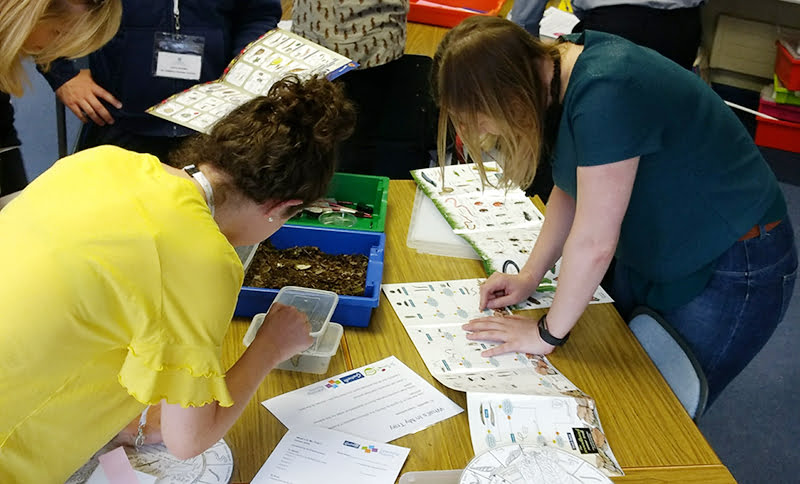Minibeast tray
This activity was created as part of a Gratnells What’s In My Tray CPD workshop for primary science teachers to support practical work and delivery of the curriculum. It can be carried out as a stand-alone activity for students or combined with other activities from the session to form a STEM carousel.
Minibeast Tray – Identify

You will need (per team of 4):
- A variety of invertebrate species from your local outdoor area (2-3 examples of 4-5 different species)
- 5 x Petri dish or similar sized vented transparent pots with lids
- 4 x 1-2cm wide paint brushes
- 4 x Hand held magnifying glass
- 3 x Wet paper towels
- 5 x Large handfuls of leaf litter and woodland detritus
- 2 x Shallow Gratnells (F1) trays with lids
- 2 x Field Studies Council Woodland Name Trail (yes/no key) or OPAL Invertebrate Identification Guide
- 1 x Paper and pencil
This activity also works for individuals or smaller teams, just increase the amount of time allocated to complete it.
Tips: Collect invertebrates carefully and as close to the time of the activity as possible. Look under logs and rocks and in the leaf litter in dark and damp locations. Use either your hands or the paint brushes to place them gently into the petri dishes. Do not collect anything that flies. Keep the different species in different petri dishes. Keep them in damp, dark and cool conditions and return them to their natural habitat as soon as possible after the activity. Choose only invertebrates that can be identified using the ID guides recommended on the equipment list. Select the ID guide that best suits the age and ability of the students you are working with.
Preparation:
Place the wet paper towels into the bottom of one shallow Gratnells (F1) tray. Add a shallow layer of leaf litter and woodland detritus. Place invertebrates into each petri dish and put the lid on. Place the petri dishes on top of the leaf litter. Put the lid on the Gratnells tray. Put all the other equipment into the second Gratnells tray and put the lid on. Store the trays in a cool and dark place until needed.
What to do:
- Approach the trays and lift the lid
- Use the Woodland Name Trail or Invertebrate ID guide to identify the different species of invertebrates. You may carefully lift the petri dishes and can use the magnifying glass to get a closer look.
- Write the common names of the invertebrates down in alphabetical order.
- 1 point per correctly identified animal.
- When the time allocated for the activity has ended, carefully put all the petri dishes back on to the leaf litter and put the lid back on the tray. Place all the other equipment back into the second tray and replace the lid.
Answers:
The invertebrates you find in your local outdoor area to use for this activity will differ depending on where you are and the time of year, you may expect to find such things as; beetles, centipedes, earthworms, millipedes, slugs, snails, spiders, true bugs and woodlouse. Use the ID guides as you are collecting the invertebrates so you have a record of the answers ahead of starting the activity.
Other things to try:
- Go outdoors and carry out a minibeast hunt and habitat creation activity.
Health & Safety
As with all Gratnells Learning Rooms What’s In My Tray activities, you should carry out your own risk assessment prior to undertaking any of the activities or demonstrations. In particular, washing hands thoroughly and covering cuts or areas of broken skin to reduce the risk of exposure to soil and waterborne pathogens.

